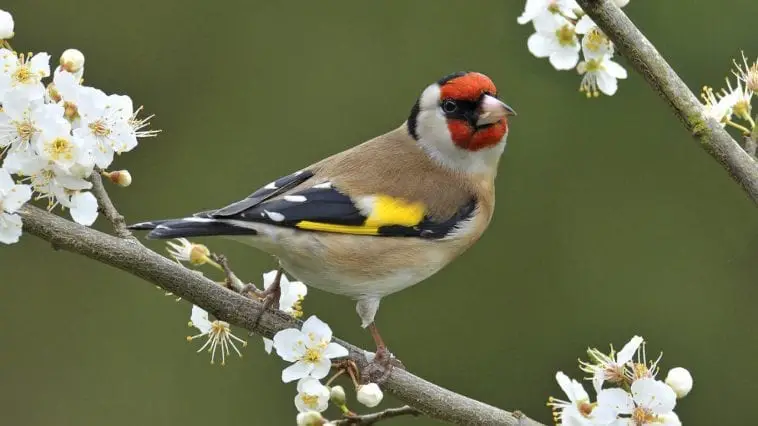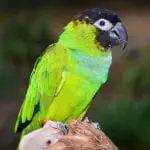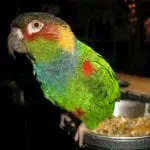Scientific Facts
| Common Name | European goldfinch |
| Scientific Name | Carduelis carduelis |
| Lifespan | 8 – 12 Years |
| Size | 4.7 – 5.1 inches |
| Mass | 0.49 – 0.67 oz. |
| Habitat | Partially wooded, open lowlands; parks, grasslands |
| Origin | Western Asia, Europe, North Africa |
Information & Physical Description
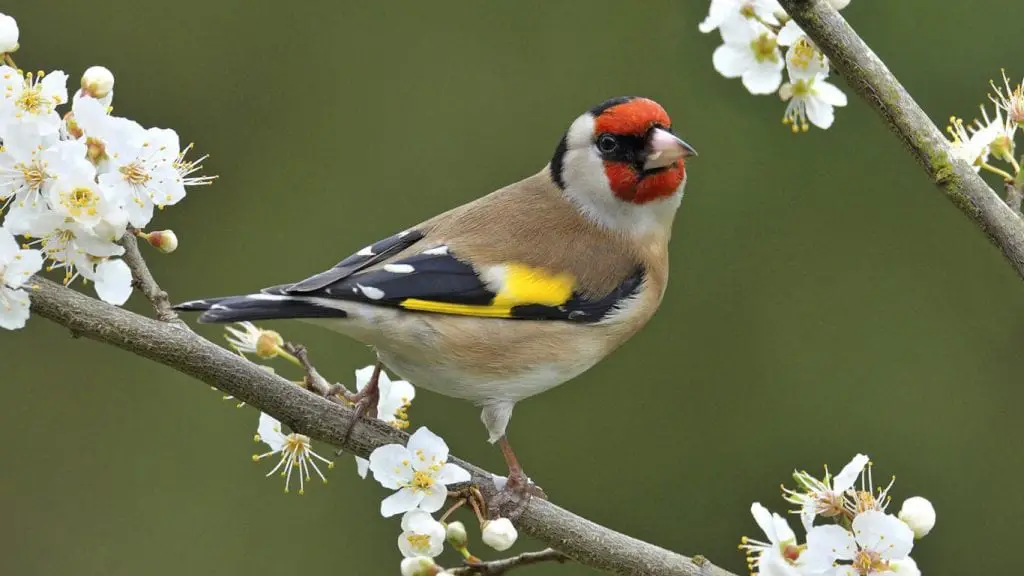
It was all the way back in 1555 when the European goldfinch became one of the very first birds to be illustrated and described in Historiae animalium by a Swiss naturalist named Conrad Gessner.
However, it wasn’t before 1758 when the first formal description of the European goldfinch was introduced in Systema Naturae, thanks to Carl Linnaeus. Back then, the binomial name for the European Goldfinch was Fringilla Carduelis, with the word “Carduelis” originating from Latin and translating into “goldfinch” in English.
Based on the specific epithet first used by Linnaeus, it was in 1760 that Mathurin Jacques Brisson, a French zoologist, introduced the genus Carduelis by tautonomy.
Nowadays, the European Goldfinch is scientifically referred to as Carduelis carduelis and is also commonly known as the goldfinch. This bird species is part of the order Passeriformes, family Fringillidae, subfamily Carduelinae.
According to the results of modern-day molecular genetic studies, experts have managed to find out that the European Goldfinch is a close relative to Carduelis Corsicana (the Corsican finch), and Carduelis citronella (the Citril finch). Other of the closest relatives of the European goldfinch include redpolls, crossbills, and greenfinches.
The subspecies of the European Goldfinch are divided into two groups, namely the carduelis group and the caniceps group.
These groups are used to amalgamate the subspecies at their boundary, and none of these groups is recognized as distinct species.
The subspecies classified in the carduelis group are known to inhabit the western part of European goldfinches’ natural range. They are distinguished by the black crowns on their heads, and include the ones found in southeastern Europe (C. c. balcanica), northern Caucasus (C. c. brevirostris), the British Isles (C. c. britannica), Scandinavia and most of Europe’s mainland (C. c. carduelis), northern Caucasus and Crimea (C. c. colchica), northeast Africa and southwest Asia (C. c. niediecki), western Siberia (C. c. frigoris), Sicily, Corsica, and Sardinia (C. c. tschusii), Macaronesia region, northwest Africa, and Iberia (C. c. parva), northwestern Kazakhstan, southwestern Russia and southern Ukraine (C. c. volgensis).
The subspecies that make up the caniceps group are found in the eastern part of the European goldfinches’ native range. They are characterized by heads colored in grey and include the ones occupying southern central Africa (C. c. caniceps), south-central Siberia (C. c. Subulata), parts of Afghanistan (C. c. paropanisi), and southern Iran (C. c. ultima).
The European goldfinch usually reaches an average weight of 0.49 to 0.67 oz. In size, these birds typically grow to 4.7 and up to 5.1 inches in length. Their wingspan is estimated at 8.3 to 9.8 inches.
Unlike other bird species that are sexually dimorphic, it can be hard to tell the female European goldfinch from the male. Both sexes share a very similar physical appearance.
The underparts in males and females alike are white in color, with breast patches and yellowish flanks with a velvety surface, while the wings are distinctly colored in yellow and black. The upperparts are colored in warm brown, as opposed to the white and blackhead and the bright red face.
The shoulder feathers are colored in black. These birds’ tails are forked, while their bills are pointed and long, colored in ivory.
In order to tell a male goldfinch from the female, one needs to have a very close inspection to be able to notice the size and coloration of the face “mask” better. Males are characterized by a visibly, darker, larger red mask. It extends all the way to just behind the bird’s eye, while in females, the red mask does not get to extend past the eye.
Juvenile European goldfinches differ from adults; however, they are unmistakable with other bird species thanks to the distinct yellow wing stripe. As compared to adults, juveniles have greyer backs and plain heads.
Lifespan
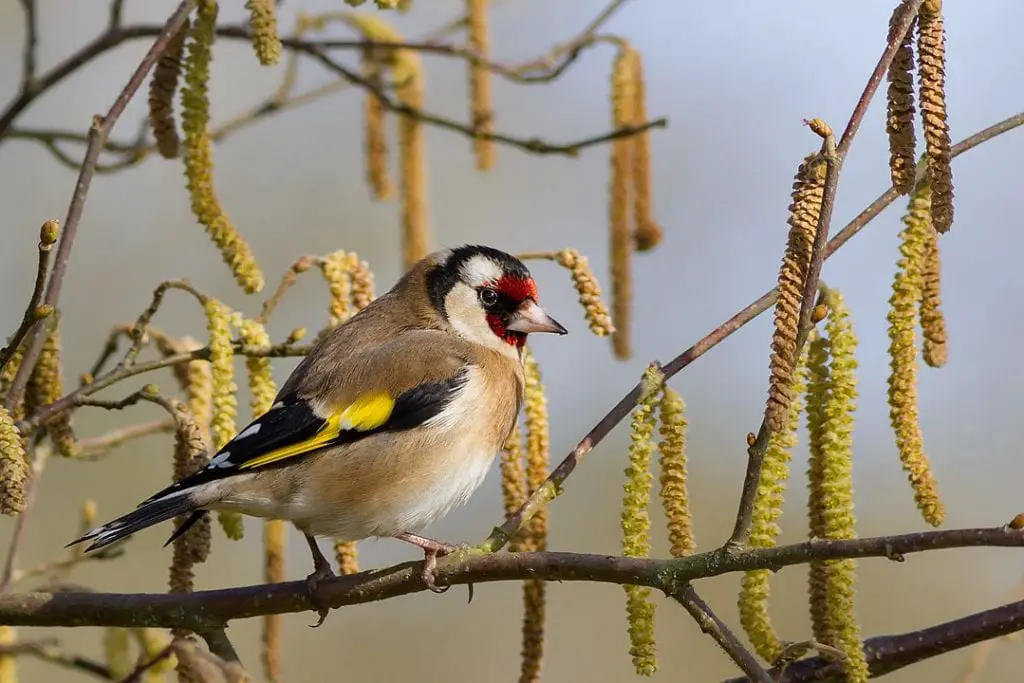
The European goldfinch is known to live for up between 8 and up to 12 years, with the average lifespan of Carduelis carduelis being set at 10 years.
Ecosystem & Habitat
Just like their name suggests, European goldfinches are native to Europe, yet it is not solely in Europe where these birds are found, but instead, they are also native to western and central Asia, as well as North Africa.
The preferred type of habitat for these birds consists of partially wooded, open lowlands. The goldfinches that occupy the milder climate west regions within their natural range are residents; however, those occupying colder regions are migratory. In fact, even in the west, European goldfinches will make local movements in order to escape the cold weather.
Additionally, the European goldfinch was successfully introduced to many parts of the world in the 19th century, including the United States, Argentina, Peru, Chile, Mexico, Canada, Uruguay, Brazil, Falkland Islands, Australia, New Zealand, and South Africa.
Ever since these birds have been introduced to other areas across the globe, apart from their natural distribution, the populations of Carduelis carduelis have increased greatly, and their range has also significantly expanded. Up-to-date, goldfinches occur throughout New Zealand, and in the territories spanning across Brisbane to the Eyre Peninsula.
Behavior
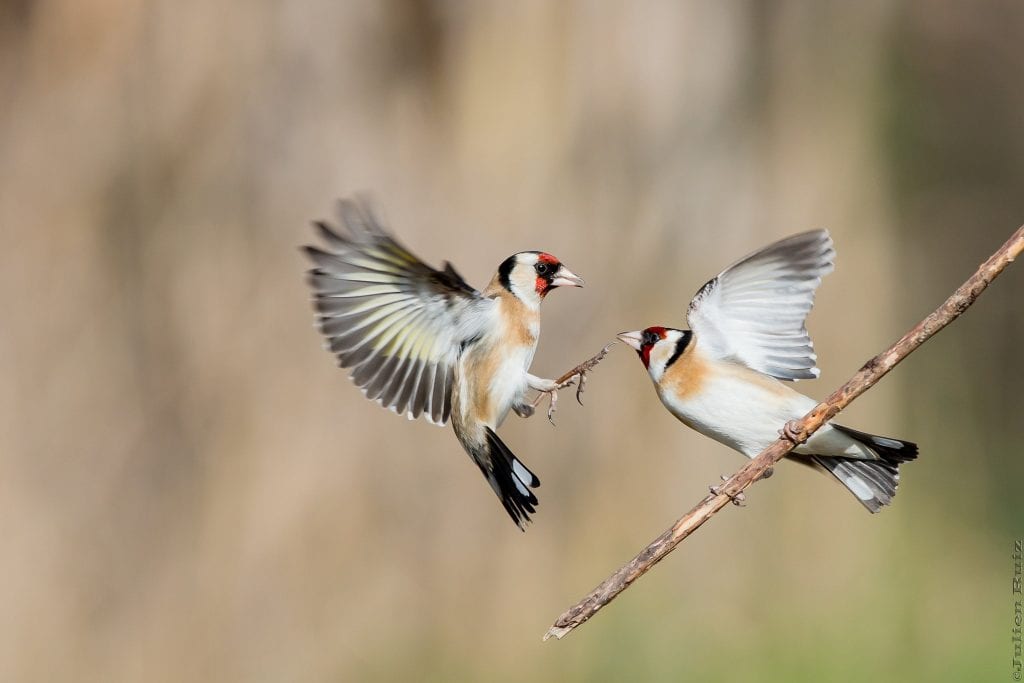
Every single day, European Goldfinches need to cover impressive distances for feeding purposes. Often feeding upside down, these amazing living creatures feed by hovering from one plant to another.
These birds are known to share a daily relationship with water availability, as they regularly drink and bathe. They usually bathe twice throughout the day – once in the morning and once at dusk.
It is thanks to their pointed, stout bills, how goldfinches can crack open the shells of various plants in order to extract the delicious seeds hidden inside.
During the winter, goldfinches can be frequently spotted on the roadsides where they feast in groups.
Although these birds have the reputation of curious, fun, beautiful feathery creations of Mother Nature, they do sometimes let the aggressive side of their behavior come to the surface. European Goldfinch is said to be aggressive often, and especially when it comes to the instances of group feeding at bird feeders, where a series of guttural “krrr-krrr” sounds between the goldfinches can be heard by the contemplator.
Courtship is also accompanied by aggression, and the display does not only involve disputes between males, but it also involves disputes among females and males. Interestingly, courtship disputes take place in flight, further accompanied by guttural sounds.
It is in March when displays begin, with the male goldfinch perching closer to a selected mated, and then stretching his wings one after another, while also swaying from one side to another. These curious movements serve to display the wings’ vivid yellow patches, and what’s more, the female is to respond by moving her body in the exact same way.
Not the least, males are known to perform courtship feeding. Females take on the courtship feeding play by quivering her wings and begging for food, just like a young bird typically would.
It is during winter when European goldfinches are to move and feed together, forming large bands. During the night, goldfinches roost securely in thick bushes, and it is often the case that they do so in big groups consisting of between 40 –100 in number.
Food & Diet
Seeds are the primary source of food in the European goldfinch’s diet. These birds have a strong preference for thistle seeds, among other favorite small seeds.
When it comes to feeding the young, insects are also gladly taken.
European goldfinches our favorite visitors to bird feeders in North America and Europe in the winter when these feathery fellows are to arrive after forming flocks that consist of about 40 (sometimes, even though rarely, more than 40) birds.
European goldfinches are particularly attracted to bird feeders containing Nyjer seeds (also non-commercially known as niger seeds). Niger seeds are small, perfect-sized for Carduelis carduelis. These seeds are especially high in oils and come from an annual plant from Africa.
Sometimes, bird care & watch enthusiasts who wish to attract European goldfinches to their backyards in the winter make use of special polycarbonate feeders that include small oval silts.
Reproduction
It is solely and entirely the female European goldfinch’s duty to build a nest. The nest-building process typically takes a week. Even though the male does accompany the female within this period, he does not contribute to the nest’s completion.
The finished nest is rather compact and neat, with a deep cup that helps to prevent the possible loss of eggs as a result of windy weather patterns. It is located above the ground, at the very end of a swaying branch, smartly hidden by the twigs’ leaves.The nest is made out of lichens and mosses. Also, it is further lined with various plant down, e.g., thistles. Using spider silk, the nest is well-attached to the tree’s twigs.
Only a couple of days after the nest has been completed, the female European goldfinch is to start laying eggs at daily intervals early every morning. A single clutch typically takes about one week of egg-laying, since one clutch usually consists of 4 – 6 eggs.
The smooth-surfaced, slightly glossy eggs are speckled in reddish-brown hues, while the rest of the egg is whitish in color.
Each egg is approximately 0.68 x 0.51 inches in size and weighs about 0.054 oz.
While the male is to feed the female, she is to incubate the eggs for between 11 – 13 days.
Males and females share parental care for the young, as both feed their chicks. At the start, they receive a combination of insects and seeds; however, as they grow, the insect material in their daily feeding starts to decrease.
The young European goldfinches are brooded by the female within the first 7 and up to 9 days. In up to 19 days after hatching, the nestlings will fledge, and the parents will continue to feed the young further for 7 and up to 9 days.
European goldfinches are known to raise two broods every year, although sometimes, they may also raise three broods per year.
How to Treat and Prevent Possible Health Issues
1. As a rule of thumb, European goldfinches are hardy birds to keep as pets, as they are not generally affected by common illnesses. However, although rarely, European goldfinches can be affected by scaly leg mites, beak swelling, swollen red eyes, soiled, fluffed or plucked feathers, and eye or nasal discharge.
The stool may become runny for a while if feeding fruits high in citric acid.
2. A sudden change in food can cause the digestive system of the bird being upset. In fact, it is not uncommon for the birds to refuse eating new food. Because of this, caregivers should only change the food they feed gradually.
3. The European goldfinch’s rest may be disturbed even by quiet noise, such as a computer or television running in the room. Noise can deprive the bird of getting the much-needed, vital, healthy amount of sleep. Therefore, caregivers should consider moving the cage to a quiet room during the night. Also, the cage can be covered at night, too.
4. Providing these birds, adequate space is a must since they are able to maintain proper metabolic rate and to stay away from getting overweight by burning energy while flying from one perch to another. Additionally, unwanted accessories can be removed from the cage to further make up for more free space to move around.
5. Apart from providing plenty of free space for European goldfinches to maintain activity and exercise, mind that boredom also leads to behavioral problems, so foraging toys can be an excellent choice to keep the birds entertained by stimulating their natural avian instinct.
6. You may need to remove mirrors if the bird gets to bond more to its own reflection rather than to other birds. Also, utilizing a mirror should not and cannot be used as a substitute for having companion birds. Any toys and accessories that have been damaged and/or worn out should be removed to prevent possible injuries.
7. Toys have to be rotated as the bird will inevitably lose interest. However, the caregiver must remember to always introduce a new, unfamiliar toy to the bird in a neutral location before placing the toy inside the cage. Like most other birds, goldfinches are extremely sensitive to changes, and so they must be allowed to see, investigate, and get used to a new toy in a safe area outside the cage prior to moving the toy inside the cage.
8. For newly acquired European goldfinches, caregivers must give the feathery fellow the needed time to get better used to its new home and surroundings. Within this period, the caregiver should only move very slowly whenever near the birdcage, and should only speak very softly, too.
9. Over time, tame European goldfinches can become very attached to their owner, and they may gladly come to his/her hand, allowing to be very gently handled. However, remember that it is not recommended to handle these birds unless you have spent a very long time together, and on any occasion of handling, mind that goldfinches are extremely delicate and fragile. Not the least, birds can be scared to death, so improper handling can cause the death of your sweet-singing pet.
10. The signs of a healthy European goldfinch include the bird gladly eating and drinking throughout the day; the bird being alert, sociable, and active; a clean, dry vent; bright, dry eyes; dry nostrils; smooth feathers; feet, legs, and beak appearing normal and not swollen, red, scaly, etc.
Red flags that may indicate possible health issues include the bird constantly sitting on the cage’s floor; coughing or wheezing; accumulations or swelling of the beak; discolored, runny stools; feathers (especially around the vent) being soiled, fluffed or plucked; nasal/eye discharge; swollen/red eyes; lack of appetite; the bird favoring one foot when NOT asleep. You should not worry if the bird sleeps on one foot, though, as this is normal, healthy behavior.
Important Note
As soon as you notice signs of illness, contact a qualified vet immediately.
As it is often the case that birds hide illness until the advanced stages when treatment is much more complicated, if possible at all, it is best to take the bird to the vet for regular checkups.
Human Interaction & Domestication
Because of their delightful song, their unique appearance, and their wide distribution and range, goldfinches are among the most commonly captive kept and bred bird species all around the world.
Unlike the case with Carduelis tristis (the American Goldfinch), which is protected by the law and may not be kept as a pet, the captive care for European goldfinches is legal, and what’s more, it has a very long history, since goldfinches were even crossed with canaries to further improve their incredible, pleasant singing abilities.
Also, breeders have managed to develop a variety of color mutations, such as albino, pastel, yellow, and tawny, so it comes as no surprise why so many bird caregivers are eager to have the European goldfinch in their collections.
It is crucial to note that if kept together with canaries, goldfinches are known to lose their native call and song, and instead, they “inherit” the song of their canary cage-mates, which is undesirable for most of the bird care enthusiasts.
Availability – Where to Get a European Goldfinch?
You can get a European goldfinch from various reputable vendors who can give you the guarantee of the bird’s health status and origin. Also, it is possible to get a European goldfinch by getting in touch with trustworthy breeders.
It is best to avoid obtaining a European goldfinch from any retailer who cannot provide proof of the bird’s captive-bred origin or who sells wild-caught specimens.
It is good to know that it was all the way back in the 19th century when thousands of wild goldfinches were trapped in Britain for the sole purpose of selling them as cage birds. Fortunately, the Society for the Protection of Birds campaign was one of the earliest to try to put an end to wild European goldfinch pet trade.
Nowadays, wildlife conservation is dedicatedly trying to limit the destruction of open space habitats, as well as bird trapping, as to protect the health and well-being of the European goldfinch living in the wild.
With all of the above being said, always choose a captive-bred European goldfinch, as this is one of the best ways to stop bird trapping for the pet trade.
Interesting Facts
1. “The Goldfinch” (“Het puttertje” in Dutch) is an animal painting of a chained goldfinch, created on the panel in 1654 by Carel Fabritius, measuring 13.2 by 9 inches. Belonging to the Mauritschius collection in The Hague, different art dealers have speculated about the worth of this artwork, some stating that it may be as high as $300 million, possibly ranking among the most valuable paintings on the planet.
2. Since goldfinches feed on thistle seeds, these birds have turned into a Christian symbol, due to Jesus Christ’s crown of thorns. Goldfinches are associated with Christ’s Passion and are frequently depicted in paintings of the Madonna and Child typical for the Italian renaissance, such as Madonna of the Goldfinch, created by artist Raphael.
3. The goldfinch is also associated with Saint Jerome. Being considered a “savior” bird in Christianity, it is often depicted with the common fly, as the latter is a symbol of disease and sin.
4. In the Concerto in D major composed by Antonio Vivaldi for flute, it was a flute to imitate the singing of the goldfinch. Other artists that have been inspired by the beauty of the European goldfinch include the poets John Keats, and Patrick Kavanagh.
5. It was in 2014 when the Pulitzer Prize for Fiction was won by Donna Tartt and her novel entitled “The Goldfinch,” with the turning point in the plot occurring when the narrator, named Theo, sees the favorite painting of his mother – “The Goldfinch” painting – in the Metropolitan Museum of Art.5. The first recorded use of the English word “goldfinch” dates back to the second half of the 14th century. The first person to use the word was Geoffrey Chaucer.
6. The scientific name for the European goldfinch originates from the Latin name Carduus, which is actually a genus of thistles.
7. The song of the European goldfinch is described as a pleasurable twittering with a soft, clear high. The song is a combination of a delightful tinkling mélange of twitters and trills, with an ever-present phrase consisting of three-syllable “teLLIT” calls. The call itself is a simple melodic “tickeLIT.”
8. The European goldfinch originated in the late Miocene-Pliocene, and thios period took place between 20 – 5 million years ago!
9. In breeding condition, goldfinches have a fully white bill. For the rest of the year, the bill ends with a blackish or greyish mark.
10. Adult Carduelis carduelis are to molt at the end of the breeding season, with the after-molt appearance being significantly less colorful up until the point when the very tips of the newly grown feathers are to wear away over time. Some individuals may begin the moult as soon as in July, and they may not be able to finish the moult completely until November!
How to Care for the European Goldfinch?
Feeding
1. Provide a balanced diet consisting of cereal seeds, grass seeds, millets, green food, and live food. Commercial-grade seed mixtures with a high percent of thistle seeds are also highly recommended. Molting and breeding birds should be provided sprouted/germinated seeds
2. Mind that the major part of the European goldfinches’ diet requires a high-quality food blend consisting of a large portion of niger seeds and sunflower hearts, as well as plenty of fresh green vegetables provided on a daily basis. These birds will not thrive if given traditional pet pelleted foods and regular seed mixes, as pelleted food should only be provided up to several times a week. Finch seed mixes can work great as a staple part of the diet.
3. Suitable fruits include bananas, melons, grapes, and apples. Suitable greens and vegetables include dandelion greens, cucumber, chickweed, collard greens, kale, broccoli, carrot tops, grass seedlings, romaine lettuce, cress, spinach. Chop fruits and veggies into small pieces prior to feeding.
4. Whenever feeding fresh fruits, remove any remnants left behind within a few hours after feeding these to the bird, so that the uneaten pieces won’t end up spoiling (rotting) in the cage. Before using the same dishes again, wash them thoroughly.
5. As a treat, you can offer a hard-boiled egg or live or dried insects, such as crickets, mealworms, wax worms, and silkworms.
6. Healthy European goldfinches do not require any supplements, as they will derive all the essential nutritious elements they need to thrive from a well-balanced diet.
7. For parents with chicks, as well as during the breeding season, increase the amount of fresh produce food and protein-based food.
8. Make sure that the cuttlebone and grit are always available
Breeding
1. Although more common in special bird rooms and outdoor aviaries, mind that breeding may also occur in a large indoor cage. Usually, providing a commercial-grade canary nest or a nesting cup, and setting it as high as possible within the cage, may be accepted by the mating pair.
2. Throughout the nesting season, commercial nesting material, as well as dried sphagnum moss, should be provided by the breeder. These birds will accept various nesting materials, such as wool, tissue paper, long grasses, and colored feathers.
3. Goldfinches can be mated to the Canaries, as well as to Siskins and Linnets.
Housing
1. House European goldfinches in planted aviaries or spacious flight-type cages. These birds can be kept and bred in large indoor cages, yet their active lifestyle and incredible acrobatic abilities make them perfectly suited to outdoor aviaries.
2. A pair of European goldfinches requires a cage that measures a minimum of 30cm x 5cm.
3. Keep the enclosure off the ground in a place or room where plenty of fresh air and sunlight are available. You can hang the enclosure from a suitable wall, or you can also keep it at eye level height.
4. Inside the cage, make sure to include softwood perches. The perches should measure approximately 0.7 inches in diameter.
5. Keep European goldfinches at normal household temperatures, and avoid sudden fluctuations. To protect the birds from intense cold, keep flight cages indoors during the winter.
6. Mind that these birds require cages that are wider rather than taller to provide ample flight space. To prevent the bird from getting trapped between the wires, opt for bar spacing of no more than 1 ¼ and up to 2’’ apart.
7. Even though you need to keep a minimum of 2-3 perches in the cage, it is a must not overcrowd the cage with excess accessories, as not to deprive the birds of enough room for flying. When choosing suitable perches, aim for varying widths, as this is extremely helpful for keeping the bird strong and healthy.
Maintenance
1. Do not clip your goldfinch’s wings. The birds need to be able to fly freely to keep up a healthy metabolic rate at all times. Also, since European goldfinches should not be handled, clipping their wings is quite unnecessary.
2. Do not trim the nails of your European goldfinch yourself. The nails should only be trimmed if they get too long and/or interfere with proper perching. Also, nails should only be trimmed by a qualified professional.
3. Use soapy water to clean the perches, toys, and the entire cage on a daily basis. Only use a non-toxic soap, such as dish liquid. Once you are done cleaning, check out whether the soap has completely rinsed off.
4. On a weekly or bi-weekly basis, you need to disinfect the perches and cage using bleach water. Make sure to keep the bird in a separate room while doing so, as bleach fumes can cause the death of your bird pet. Before you put the bird back into the cage, check if the bleach smell is completely gone. Also, you can disinfect the cage all naturally by allowing it to air dry in generous sunlight.
5. Don’t forget to religiously wash your hands every time before and after handling your European goldfinch, as well as whenever cleaning the cage and the accessories.
6. Provide the birds with a shallow dish filled with fresh water, so that they can freely maintain their healthy, beautiful plumage by bathing daily.
Temperament
1. As a rule of thumb, goldfinches are known to live peacefully in large groups, and they are extremely social birds. In fact, in order to stay happy and healthy, they require a lot of interaction with other birds.
2. Mind that sometimes, European goldfinches may become aggressive towards other bird species, yet as long as the cage is large enough, these birds can thrive in colonial situations. However, they do get along with birds of their own species very well.
3. It is best to keep at least a pair of two European goldfinches together. If bred in mixed aviaries, they can be kept with other similar-sized birds.
FAQ Section
What Do European Goldfinches Eat?
European goldfinches eat mainly appropriately-sized seeds, and in particular, teasels and thistles. Also, they eat foliage, grains, and only occasionally, they do also eat insects.
How to Breed European Goldfinches?
To breed European goldfinches in captivity, the birds must be provided several small and narrow, well-camouflaged nests placed at different locations within the cage, so that the female bird can choose one of them as desired. Whether the birds are to be bred in a large cage or in an aviary, it is best to introduce the couple into a separate enclosure in March.
Do European Goldfinches Migrate?
Some European goldfinchesmigrate in winter, such as the UK goldfinches, flying all the way to Spain. However, other goldfinches that inhabit the western parts of their natural range do not migrate, as they are exposed to a more favorable, milder weather, yet they do often engage in short local movements in the winter.
What Does the Goldfinch Symbolize?
The goldfinch is considered a “savior” bird, symbolizing passion, persistence, fruitfulness, and endurance.What Is the Spiritual Meaning of Seeing a Goldfinch?
According to ancient texts, seeing a goldfinch is associated with joy, abundance, wealth, prosperity, and happiness.
How Can You Tell whether the European Goldfinch is Male or Female?
There is only very little difference between immature and adult European goldfinches, as well as between males and females. To tell apart a male from the female goldfinch, look at the red mask, as it is visibly brighter and larger in males.
Where Do European Goldfinches Sleep at Night?
As soon as the light starts fading in the evening, European goldfinches are to head back to their preferred type of roost site, such as the inner branches of beech and oak trees, where they often sleep together in flocks of about 40 birds.
Do European Goldfinches Pair for Life?
No, European goldfinches do not pair for life, but instead, like robins and chickadees, the pair only stays together for one nesting period.
How to Attract Goldfinches?
To attract goldfinches to your garden, place nyjer seeds and sunflowers seeds in your bird feeder. Make sure the seeds you choose are of high-quality, and always store them in a clean, cool, and dark place.
Do European Goldfinches Eat Upside Down?
European goldfinches have the reputation of colorful acrobats, and that’s great because of the fact they can feed upside down!
Can You Keep European Goldfinches as Pets?
European goldfinches have been long kept and bred in captivity. In the USA, it is legal to keep the European goldfinch as a pet, and so is the case with most of the countries across the globe.
Do European Goldfinches Make Good Pets?
European goldfinches can make wonderful pets for caregivers who love watching birds, yet who do not crave for a companion bird that enjoys being handled since this is not the case with these finches. Also, despite being easy to take care of in general, goldfinches do require special attention during the breeding season.
Are European Goldfinches Endangered?
Due to illegal trapping, the populations of European Goldfinches were rapidly decreased during the last century. Nowadays, the populations are stable, with an increasing population trend, and European goldfinches are listed as Least Concern by the IUCN Red List. However, possible declines related to the consequences of climate change, habitat loss, and poisoning with pesticides used in agriculture may serious threats to these bird species in the future.

